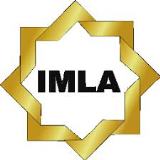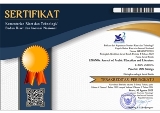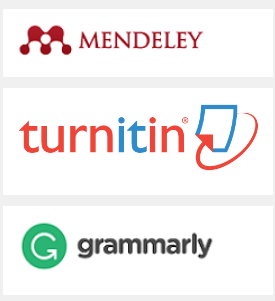Developing Technology-Based Authentic Assessment for Maharah Kitabah in the Ministry of Religious Affairs' Arabic Textbook
DOI:
https://doi.org/10.18326/lisania.v9i1.174-199Keywords:
Learning Technology, Authentic Assessment, Arabic Textbook, Arabic Writing SkillsAbstract
The Arabic textbook for Grade X MA, published by the Ministry of Religious Affairs in 2020, still requires development in its assessment component to align with the demands of the digital era and 21st-century learning needs. This article aims to analyze and develop a technology-based authentic assessment model for Maharah Kitabah that can be integrated into the Arabic language textbook for grade X MA published by the Ministry of Religious Affairs in 2020. The study employs the type of Research and Development (R&D) with the ADDIE model to the development phase, with a descriptive method to analyze the components of the Maharah Kitabah assessment found in the textbook. The results showed that technology integration in authentic assessment can be done through several platforms: (1) Google Docs for collaborative writing and real-time feedback, (2) Canva for visual presentation development and creative narrative, (3) Augmented Reality for interactive learning, and object-based assessment, (4) Padlet for collaboration and idea sharing, (5) Seesaw for digital portfolios and learning documentation, and (6) Blogger for uploading materials and interacting through the comments column. Each platform has a comprehensive assessment rubric to objectively measure students' writing ability. This development aims to enhance the efficiency of the Maharah Kitabah assessment, foster students' engagement in learning, and better prepare them to meet the demands of the digital era.
References
Ajjawi, R., Tai, J., Dollinger, M., Dawson, P., Boud, D., & Bearman, M. (2024). From authentic assessment to authenticity in assessment: Broadening perspectives. Assessment & Evaluation in Higher Education, 49(4), 499–510. https://doi.org/10.1080/02602938.2023.2271193
Amanda, M. D., Megawati, F., & Mandarani, V. (2024). Does teaching writing through Canva application assist students’ writing performance?. Journal of Research on English and Language Learning (J-REaLL), 5(1), 100–109. https://doi.org/10.33474/j-reall.v5i1.21361
Arena, F., Collotta, M., Pau, G., & Termine, F. (2022). An Overview of Augmented Reality. Computers, 11(2), 28. https://doi.org/10.3390/computers11020028
Ashadevi, D., & Selvi, M. (2017). Google Docs: An Effective Collaborative Tool For Graduates To Perform Academic Activities In The Cloud. IJDR: International Journal of Development Research, 07(08).
Athina, V. (2024). Attitudes of Greek Foreign Language Teachers Regarding the Role of Authentic Assessment in Foreign Language Teaching. Futurity Education, 4(1), 258–273. https://doi.org/10.57125/FED.2024.03.25.13
Bahrani, T. (2011). Technology as an Assessment Tool in Language Learning. International Journal of English Linguistics, 1(2), p295. https://doi.org/10.5539/ijel.v1n2p295
Bahruddin, U., Syuhadak, S., & Sutaman, S. (2021). Iktisāb al-Lugah al-‘Arabiyyah min al-Bī`ah al-Iṣṭinā’iyyah bi Jāmi’ah Maulānā Mālik Ibrāhῑm Malang. LISANIA: Journal of Arabic Education and Literature, 5(1), 71–87. https://doi.org/10.18326/lisania.v5i1.71-87
Boki, T. A., Yuanita, S. I., & Azizah, N. (2022). Pengaruh Aplikasi Seesaw Terhadap Kemampuan Bahasa Pada Anak Usia Dini. 5(1).
Darmawan, S., & Komaro, M. (2023). Application of Augmented Reality (AR) In Vocational Education: A Systematic Literature Review. VANOS Journal of Mechanical Engineering Education, 8(2), 110. https://doi.org/10.30870/vanos.v8i2.20841
El-Sherbiny, Doaa. M. A. E.-S. (2024). Leveraging the Effect of Canva on Developing Students’ Report Writing Skills and Their Perception towards the Application. Egyptian Journal of Educational Sciences, 4(2), 35–64. https://doi.org/10.21608/ejes.2024.413503
Gulikers, J. T. M., Bastiaens, T. J., & Kirschner, P. A. (2004). A five-dimensional framework for authentic assessment. Educational Technology Research and Development, 52(3), 67–86. https://doi.org/10.1007/BF02504676
Haq, A. Z., Akmansyah, M., Erlina, E., & Koderi, K. (2024). Technology integration in arabic language learning: A literature review on the effectiveness of e-learning and mobile applications. Journal of Research in Instructional, 4(2). https://doi.org/10.30862/jri.v4i2.473
Hardiyanto, F. E. (2020). Model Penilaian Produktif Mata Kuliah Menulis Berbasis Nilai Humanis. Jurnal Pendidikan Bahasa dan Sastra Indonesia, 9(1), 66–70. https://doi.org/10.15294/jpbsi.v9i1.38686
Hasanah, H., & Triastuti, L. (2024). Urgensi Maharah Kitabah (Keterampilan Menulis) dalam Pembelajaran Kaligrafi Al-Qur’an.
Hidayat, F., & Nizar, M. (2021). Model Addie (Analysis, Design, Development, Implementation And Evaluation) Dalam Pembelajaran Pendidikan Agama Islam. Jurnal Inovasi Pendidikan Agama Islam (JIPAI), 1(1), 28–38. https://doi.org/10.15575/jipai.v1i1.11042
Hu, J., & Liu, Y. (2023). The Scientific Basis of Authentic Assessment and Its Implementation in English as a Foreign Language Education. SHS Web of Conferences, 174, 01023. https://doi.org/10.1051/shsconf/202317401023
Ilyas, M. (2020). Bahasa Arab MA Kelas XI (Cetakan ke-1). Kementerian Agama RI.
Kamila, I. Z. (2022). Evaluasi Pembelajaran Bahasa Arab Dengan Penilaian Autentik Di Kelas Xi Ips Madrasah Aliyah Al Amiriyyah Blokagung Banyuwangi Tahun Ajaran 2021-2022. Fakultas Tarbiyah dan Keguruan: Universitas Islam Darussalam.
Maspeke, N. M., Baroroh, U., Mandaka, D. A. P., Wahyuni, H., & Nur, Y. M. (2024). Inovasi Penilaian Autentik Pada Buku Bahasa Arab Kelas VII Madrasah Tsanawiyah Terbitan Kemenag 2020. Al Mi’yar: Jurnal Ilmiah Pembelajaran Bahasa Arab dan Kebahasaaraban, 7(2). https://jurnal.stiq-amuntai.ac.id/index.php/al-miyar/index
Mohammad D. Aldhafiri & Akram Albasheer. (2021). The Degree of Employing Authentic Assessment Strategies and Tools in the Competency Curriculum from the Arabic Language Teachers’ Point of View in the State of Kuwait. Journal of Educational and Psychological Studies [JEPS]. https://doi.org/10.53543/jeps.vol15iss1pp27-48
Nabhan, S., & Sa’diyah, H. (2021). Collaborative Writing Using Google Docs in an EFL Classroom: Voices from High School Students. VELES Voices of English Language Education Society, 5(2), 156–166. https://doi.org/10.29408/veles.v5i2.3863
Noor, M., & Karani, E. (2023). The Effectiveness of Canva Application as a Media in Writing Greeting Card at the Eight Grade of SMP Negeri 12 Banjarmasin. Journal on Education, 5(3), 9540–9548. https://doi.org/10.31004/joe.v5i3.1826
Norhidayah, & Priyatmi, T. (2021). Pembelajaran Maharah Kitabah Berbasis Online. Konasbara: Prosiding Konferensi Nasional Bahasa Arab VII.
NurSodiq, A., Winarti, W., & Hariansyah, O. (2023). Pengenalan Google Docs Sebagai Media Pembelajaran Pada Madrasah Tsanawiyah (Mts) Mathlaul Anwar Pamulang. 1(3).
Okpatrioka. (2023). Research And Development (R&D) Penelitian Yang Inovatif Dalam Pendidikan. Dharma Acariya Nusantara: Jurnal Pendidikan, Bahasa dan Budaya, 1(1), 86–100. https://doi.org/10.47861/jdan.v1i1.154
Pujiarto, P., Nurbidayah, G. A., Kurniasih, K., Yuningsih, S. F., Suryani, Y., Puspitasari, I., Purwati, S., & Ahsanty, R. (2023). Inovasi Penggunaan Program Seesaw sebagai Media Pembelajaran Digital dan Laporan Portofolio untuk Meningkatkan Kompetensi Guru PAUD di Kecamatan Telukjambe Barat Karawang. E-Dimas: Jurnal Pengabdian kepada Masyarakat, 14(4), 784–789. https://doi.org/10.26877/e-dimas.v14i4.15954
Ramadhani, A. S., Dewi, U., Syahnaz, M., & Kihwele, J. E. (2023). The Effectiveness of Using Padlet in Collaborative Writing Based on Students’ Perceptions. Child Education Journal, 5(1), 36–48. https://doi.org/10.33086/cej.v5i1.3767
Rangkuti, N. A., Lubis, F., Handayani, T., & Sigalingging, D. L. (2019). Blog Sebagai Media Pembelajaran Pada Mata Pelajaran Bahasa Indonesia. Prosiding Seminar Nasional PBSIII.
Resi Agustien. (2020). Pengembangan Instrumen Penilaian Autentik Berbasis Kurikulum 2013 pada Buku Ajar Bahasa Arab Kelas X Semester 1 Madrasah Aliyah. La-Tahzan: Jurnal Pendidikan Islam, 12(1), 52–70. https://doi.org/10.62490/latahzan.v12i1.85
Rozali, Y. A. (2022). Penggunaan Analisis Konten dan Analisis Tematik. Forum Ilmiah, 19(1).
Sartono. (2016). Pemanfaatan Blog Sebagai Media Pembelajaran Alternatif di Sekolah. Transformatika, 12(1).
Sholihah, U., & Setyandari, A. (2018). The Use of “Google Docs” in Teaching Writing: An Alternative Way of Collaboration in Writing. The 2nd International Conference on Technology, Education, and Social Science.
Sriyanta, A. (2022). Penilaian Autentik Berbasis Teknologi Informasi Dan Komunikasi (TIK) Dan Penerapannya Pada Pendidikan Agama Islam. Management Of Education: Jurnal Manajemen Pendidikan Islam, 8(2). https://jurnal.uin-antasari.ac.id/index.php/moe/article/download/12414/3834
Suryani, I., & Daulay, S. H. (2022). Students’ Perceptions on Writing Activities by Using Padlet Application. The Proceedings of the English Language Teaching, Literature, and Translation (ELTLT), 11(1).
Wiharto, M. (2017). Efektivitas Penggunaan Blog Dalam Pembelajaran. Forum Ilmiah, 14(1).
Downloads
Published
Issue
Section
License
Copyright (c) 2025 Eka Dewi Mutiara, R. Umi Baroroh Baroroh, Abdul Aziz Fathullah'ali Abdul Bari

This work is licensed under a Creative Commons Attribution-NonCommercial-ShareAlike 4.0 International License.






